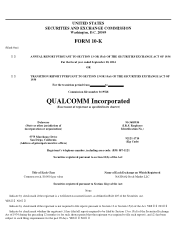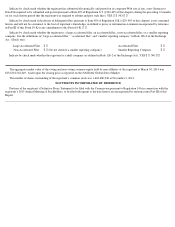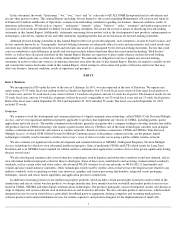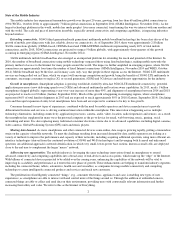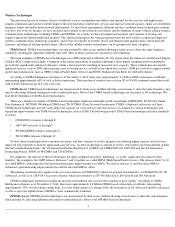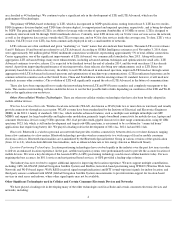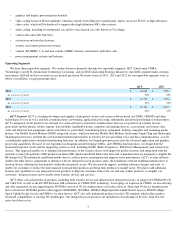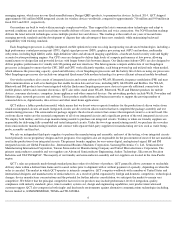Qualcomm 2014 Annual Report Download - page 6
Download and view the complete annual report
Please find page 6 of the 2014 Qualcomm annual report below. You can navigate through the pages in the report by either clicking on the pages listed below, or by using the keyword search tool below to find specific information within the annual report.
In this document, the words “Qualcomm,” “we,” “our,” “ours” and “us” refer only to QUALCOMM Incorporated and its subsidiaries and
not any other person or entity. This Annual Report (including, but not limited to, the section regarding Management’s Discussion and Analysis
of Financial Condition and Results of Operations) contains forward-looking statements regarding our business, financial condition, results of
operations and prospects. Words such as “expects,” “anticipates,” “intends,” “plans,” “believes,” “seeks,” “estimates” and similar expressions or
variations of such words are intended to identify forward-looking statements, but are not the exclusive means of identifying forward-looking
statements in this Annual Report. Additionally, statements concerning future matters such as the development of new products, enhancements or
technologies, sales levels, expense levels and other statements regarding matters that are not historical are forward-looking statements.
Although forward-looking statements in this Annual Report reflect our good faith judgment, such statements can only be based on facts and
factors currently known by us. Consequently, forward-looking statements are inherently subject to risks and uncertainties and actual results and
outcomes may differ materially from the results and outcomes discussed in or anticipated by the forward-looking statements. Factors that could
cause or contribute to such differences in results and outcomes include without limitation those discussed under the heading “Risk Factors”
below, as well as those discussed elsewhere in this Annual Report. Readers are urged not to place undue reliance on these forward-looking
statements, which speak only as of the date of this Annual Report. We undertake no obligation to revise or update any forward-looking
statements in order to reflect any event or circumstance that may arise after the date of this Annual Report. Readers are urged to carefully review
and consider the various disclosures made in this Annual Report, which attempt to advise interested parties of the risks and factors that may
affect our business, financial condition, results of operations and prospects.
PART I
Item 1. Business
We incorporated in 1985 under the laws of the state of California. In 1991, we reincorporated in the state of Delaware. We operate and
report using a 52-53 week fiscal year ending on the last Sunday in September. Our 52-week fiscal years consist of four equal fiscal quarters of
13 weeks each, and our 53-week fiscal years consist of three 13-week fiscal quarters and one 14-
week fiscal quarter. The financial results for our
53-week fiscal years and our 14-week fiscal quarters will not be exactly comparable to our 52-week fiscal years and our 13-week fiscal quarters.
Both of the fiscal years ended September 28, 2014 and September 29, 2013 included 52 weeks. The fiscal year ended September 30, 2012
included 53 weeks.
Overview
We continue to lead the development and commercialization of a digital communication technology called CDMA (Code Division Multiple
Access), and we own significant intellectual property applicable to products that implement any version of CDMA, including patents, patent
applications and trade secrets. The mobile communications industry generally recognizes that a company seeking to develop, manufacture and/or
sell products that use CDMA technology will require a patent license from us. CDMA is one of the main technologies currently used in digital
wireless communications networks (also known as wireless networks). Based on wireless connections, CDMA and TDMA (Time Division
Multiple Access), of which GSM (Global System for Mobile Communications) is the primary commercial form, are the primary digital
technologies currently used to transmit a wireless device user’s voice or data over radio waves using a public cellular wireless network.
We also continue our significant role in the development and commercialization of OFDMA (Orthogonal Frequency Division Multiple
Access) technology for which we own substantial intellectual property. Sales of multimode CDMA and LTE (which stands for Long Term
Evolution and is an OFDMA-based standard for cellular wireless communication applications) wireless devices have grown significantly during
the past several years.
We also develop and commercialize several other key technologies used in handsets and tablets that contribute to end-user demand, and we
own substantial intellectual property related to these technologies. Some of these were contributed to and are being commercialized as industry
standards, such as certain audio and video codecs, the advanced WLAN (wireless local area networks, or Wi-Fi) 802.11 functionality and
volatile and non-volatile memory controllers. Other technologies widely used by wireless devices that we have developed are not related to any
industry standards, such as operating systems, user interfaces, graphics and camera processing functionality, integrated circuit packaging
techniques, sensors and sensor fusion algorithms and application processor architectures.
In addition to licensing portions of our intellectual property portfolio, which includes certain patent rights essential to and/or useful in the
manufacture and sale of certain wireless products, we design, manufacture, have manufactured on our behalf and market products and services
based on CDMA, OFDMA and other digital communications technologies. Our products principally consist of integrated circuits (also known as
chips or chipsets) and system software used in mobile devices and in wireless networks. We also sell other products and services, which include:
integrated circuits for use in wired devices, particularly broadband gateway equipment, desktop computers and streaming media players;
software products and content enablement services for wireless operators; and products designed for the implementation of small cells.
1


